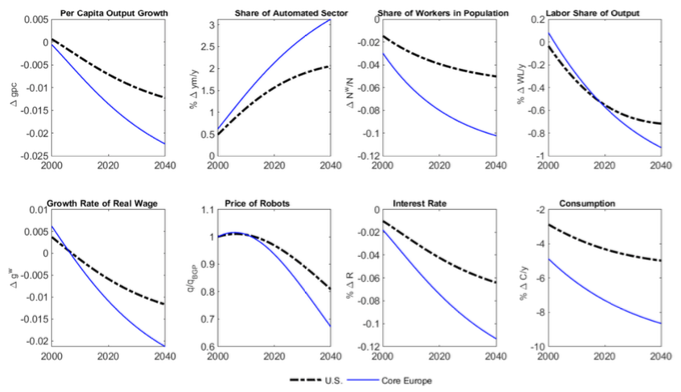Low productivity growth and interest rates and falling labour income shares are macroeconomic signs of our times, and, it seems, are here to stay. Demographic changes (low fertility, continuously increasing longevity, and population ageing associated with the retirement of baby boomers) are thought to be relevant to the fall in the natural interest rate (Aksoy et al. 2019, Carvalho et al. 2016) and the revival of the secular stagnation hypothesis (Summers 2014). On the one hand, changes in demographic structure in the last four decades are found to be negatively associated with growth and innovation (Aksoy et al. 2019). On the other hand, demographics have been more recently shown to foster automation, and, hence, productivity growth (Acemoglu and Restrepo 2018a). Will demographic trends continue to exert negative pressure on productivity growth, contributing to its poor performance in the last decade and beyond? Or might the possibilities brought by digitalisation and a new wave of automation (robotics and artificial intelligence), which are fostered by ageing, reverse the current trend?
A macro model of demographic and technological changes
We have studied (and quantified) the implications of the interactions between demographics and technological progress for growth and the labour income share (Basso and Jimeno 2019) focusing on three main elements:
- A simple life cycle framework in which fertility, longevity, and retirement age determine the age structure and the labour supply across different sectors (as in Gertler 1999).
- A production structure with two sectors: one labour-intensive, using capital, intermediate goods, and labour (labour intensive sector) as inputs; and another automated, in which the inputs are capital, intermediate goods, and robots (similar to Acemoglu and Restrepo 2018b).
- An R&D sector which comprises of two activities, innovation (creation of new goods) and automation (development of procedures such that goods may be produced by robots, instead of employing labour).
Thus, the primary source of growth is innovation – that is, the origination of new ideas (goods) that increase overall productivity (productivity effect). By creating new goods, innovation also creates new job opportunities (reinstatement effect). Eventually, as robots are more productive than labour, automation also increases productivity but destroys jobs (displacement effect).
What are the effects of demographic changes in this setup? We identify three key channels:
- First, changes in labour supply affect factor prices (wages and the price of robots), altering the relative profitability of labour-intensive and automated sectors, and, hence, the incentives to innovate and automate.
- Second, demographic changes affect savings and the interest rate, altering the amount of resources available for investment in capital accumulation, innovation, and automation.
- Third, insofar as the efficiency of R&D may depend on the age structure of population, the arrival rate of new goods is also affected when the population age structure changes.
Population growth and ageing in the long run
Automation, by reallocating production from a labour-intensive sector to an automated sector, could eventually generate an imbalance between the labour and robot income shares, preventing the economy from reaching a long-run balanced growth path with constant factor shares and fully eliminating labour as a fundamental factor of production. We prevent such labour-free singularity by restricting the productivity gain of robot manufacturing, sustaining its relative price in terms of the final good. Ultimately, as the economy develops and gains in complexity, the robots that are capable of replacing labour in the production of an increasing variety of goods must also become harder to produce.
Focusing on balanced growth paths defined under this restriction, there are two important analytical conclusions.
- A fall in fertility leads the economy to a new balanced growth path with lower GDP per capita growth, a higher degree of automation, and a lower labour income share.
- The balanced growth path of an economy with an older population (with constant working-age population growth) entails lower interest rates, a higher degree of automation, and a lower labour income share.
These results arise from the trade-offs between innovation and automation. One a balanced growth path, innovation and automation must grow at the same rate. Hence, the creation of new goods, which increases labour productivity, is the main source of technological change. On the one hand, a fall in labour supply growth leads to a decrease in the incentive to innovate, pushing the growth rate down. On the other hand, lower labour supply growth increases the incentive to automate, and thus the robots’ production share of output increases and the labour income share falls.
Demographic transition - a pessimistic outlook
Using standard calibration and the population shares of workers (aged 20-65) and retirees (over 65) in 1993 and 2055, we analyse the consequences of demographic changes over the next decades predicted for the US and for ‘core Europe’ (defined as the aggregation of Germany, France, Italy, and Spain). Figure 1 shows the main results.
Figure 1 Demographic changes in US and Europe
Our interpretation of these results is as follows. As mortality decreases, savings increase and the interest rate falls, providing more resources for innovation, automation, and capital investments. As fertility decreases, the new cohort of workers entering the labour market also decreases, pushing wages up and reducing the profitability of the labour-intensive sector, boosting automation. As robots are more productive than labour, productivity rises. Both of these mechanisms lead to an initial increase in output growth. However, as profits of the labour-intensive sector fall, the investment in innovation decreases. Moreover, a drop in fertility implies that the pool of workers available for innovation decreases. As the growth of new goods decreases, overall growth is reduced, hampering the pace of automation in the future.
Therefore, lower fertility and higher longevity lead to higher automation both in the US and in Europe, with a stronger effect in Europe, as observed in the available data on robot density. Despite the positive effects of automation, as resources are diverted from innovation, population changes lead to lower output growth in the medium run. Our results indicate that demographics may also contribute to reinforcing three observed trends in the past decades – namely, the fall in real interest rates, the fall in labour income shares (Elsby et al. 2013, Karabarbounis and Neiman 2014), and the fall in the price of robots (Graetz and Michaels 2018).
There are alternative specifications that could make this pessimistic outcome less likely. For instance, scenarios that contemplate a delay of retirement age, the migration of workers from production to R&D, an increasing gap of productivity between robots and workers, and an increasing participation of machines in innovation (artificial intelligence) generate a mitigation of the negative impacts of the demographic changes on growth. However, there are also scenarios in which automation increases very quickly (‘robocalypse’), significantly depressing the labour income share and future growth. That happens when the balanced growth path restriction is not enforced during the transition, and, therefore, as automation increases, robots are also produced more efficiently and their price falls.
Conclusions
Admittedly, there is high uncertainty about the nature of future technological changes brought up by robotics and artificial intelligence. In particular, the extent to which they could be complementary to labour (as the skill-biased technological change of the past) or will substitute workers to the extent of eliminating human labour as a fundamental input in the production of some goods, services, and ideas (R&D), is still an open question. Nevertheless, the interactions of demographic and technological changes, highlighted by the transmission mechanisms that we describe, have new implications for growth and inequalities that may need to be faced under new paradigms on both the academic and the policy fronts.
References
Acemoglu, D, and P Restrepo (2018a), “Demographics and Automation," NBER Working Paper 24421.
Acemoglu, D, and P Restrepo (2018b), “The Race between Man and Machine: Implications of Technology for Growth, Factor Shares, and Employment”, American Economic Review, 108 (6), 1488-1542.
Aksoy, Y, H S Basso, R P Smith, and T Grasl (2019), “Demographic Structure and Macroeconomic Trends”, American Economic Journal: Macroeconomics, 11 (1), 193-222.
Basso, H S and J F Jimeno (2019), “From Secular Stagnation to Robocalypse? Implications of Demographic and Technological Changes”, CEPR Discussion Paper 14092.
Carvalho, C, A Ferrero, and F Nechio (2016), “Demographics and Real Interest Rates: Inspecting the Mechanism”, European Economic Review, 88, 208-26.
Elsby, M, B Hobijn, and A Sahin (2013), “The Decline of the U.S. Labor Share”, Brookings Papers on Economic Activity, 44 (2, Fall), 1-63.
Gertler, M (1999), “Government debt and social security in a life-cycle economy”, Carnegie-Rochester Conference Series on Public Policy, 50 (1), 61-110.
Karabarbounis, L, and B Neiman (2014), “The Global Decline of the Labor Share”, Quarterly Journal of Economics, 129 (1), 61-103
Graetz, G, and G Michaels (2018), “Robots at Work," Review of Economics and Statistics, 100 (5), 753-768.
Summers, L (2014), “U.S. Economic Prospects: Secular Stagnation, Hysteresis, and the Zero Lower Bound”, Business Economics, 49 (2).




